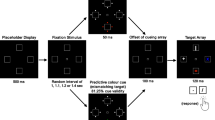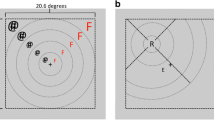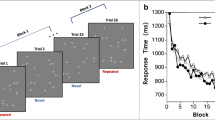Abstract
Cueing a target by abrupt visual stimuli enhances its perception in a rapid but short-lived fashion, an effect known as transient attention. Our recent study showed that when targets are cued at a constant, central location, the emergence of the transient performance pattern was dependent on the presence of competing distractors, whereas targets presented in isolation were enhanced in a sustained manner (Wilschut et al., PLoS ONE, 6:e27661, 2011). The current study examined in more detail whether the transience depends on the specific nature of the competition. We first replicated and extended the competition-dependent transient pattern for peripheral and variable target locations. We then investigated the role of feature similarity, compatibility, and proximity. Both competition by feature similarity and compatibility between the target and distractors were found to impair performance, but effects were additive with the effects of the cueing interval and did not change the transient performance function. Varying the spatial distance between target and distractors yielded mixed evidence, but here too a transient pattern could be observed for targets flanked by both close and far distractors. The results thus show that the presence or absence of competition determines whether attention appears transient or sustained, while the specific nature of the competition (in terms of location or feature) affects selection independent of time.






Similar content being viewed by others
References
Andersen, S. K., Fuchs, S., & Müller, M. M. (2011). Effects of feature-selective and spatial attention at different stages of visual processing. Journal of Cognitive Neuroscience, 23(1), 238–246.
Andersen, S. K., Müller, M. M., & Hillyard, S. A. (2009). Color-selective attention need not be mediated by spatial attention. Journal of Vision, 9(6), 1–7.
Baylis, G. C., & Driver, J. (1992). Visual parsing and response competition: the effect of grouping factors. Perception and Psychophysics, 51(2), 145–162.
Becker, S. I. (2007). Irrelevant singletons in pop-out search: attentional capture or filtering costs? Journal of Experimental Psychology: Human Perception and Performance, 33(4), 764–787.
Benoni, H., & Tsal, Y. (2010). Where have we gone wrong? Perceptual load does not affect selective attention. Vision Research, 50, 1292–1298.
Bouma, H. (1970). Interaction effects in parafoveal letter recognition. Nature, 226, 177–178.
Breitmeyer, B. G., Kafaligönül, H., Öğmen, H., Mardon, L., Todd, S., & Ziegler, R. (2006). Meta- and paracontrast reveal differences between contour- and brightness-processing mechanisms. Vision Research, 46, 2645–2658.
Carrasco, M. (2011). Visual attention: the past 25 years. Vision Research, 51, 1484–1525.
Carrasco, M., Ling, S., & Read, S. (2004). Attention alters appearance. Nature Neuroscience, 7(3), 308–313.
Carrasco, M., Penpeci-Talgar, C., & Eckstein, M. (2000). Spatial covert attention increases contrast sensitivity across the CSF: support for signal enhancement. Vision Research, 40, 1203–1215.
Chastain, G., & Cheal, M. L. (1997). Facilitatory or inhibitory nontarget effects in the location-cuing paradigm. Consciousness and Cognition, 6, 328–347.
Chastain, G., Cheal, M. L., & Lyon, D. R. (1996). Attention and nontarget effects in the location-cueing paradigm. Perception and Psychophysics, 58(2), 300–309.
Cheal, M., & Lyon, D. R. (1991). Central and peripheral precuing of forced-choice discrimination. The Quarterly Journal of Experimental Psychology, 43A(4), 859–880.
Dakin, S. C., Bex, P. J., Cass, J. R., & Watt, R. J. (2009). Dissociable effects of attention and crowding on orientation averaging. Journal of Vision, 9(28), 1–16.
Dosher, B. A., & Lu, Z.-L. (2000). Noise exclusion in spatial attention. Psychological Science, 11(2), 139–146.
Enns, J. T., & Di Lollo, V. (1997). Object substitution: a new form of masking in unattended visual locations. Psychological Science, 8(2), 135–139.
Eriksen, B. A., & Eriksen, C. W. (1974). Effects of noise letters upon the identification of target letters in a nonsearch task. Perception and Psychophysics, 16(1), 143–149.
Eriksen, C. W., & St. James, J. D. (1986). Visual attention within and around the field of focal attention: a zoom lens model. Perception and Psychophysics, 40(4), 225–240.
Folk, C. L., & Remington, R. W. (1998). Selectivity in distraction by irrelevant featural singletons: evidence for two forms of attentional capture. Journal of Experimental Psychology: Human Perception and Performance, 24(3), 847–858.
Greenwood, J. A., Bex, P. J., & Dakin, S. C. (2010). Crowding changes appearance. Current Biology, 20, 496–501.
Hayden, B. Y., & Gallant, J. L. (2005). Time course of attention reveals different mechanisms for spatial and feature-based attention in area V4. Neuron, 47, 637–643.
He, S., Cavanagh, P., & Intriligator, J. (1996). Attentional resolution and the locus of visual awareness. Nature, 383, 334–337.
Hu, F. K., Samuel, A. G., & Chan, A. S. (2011). Eliminating inhibition of return by changing salient nonspatial attributes in a complex environment. Journal of Experimental Psychology: General, 140(1), 35–50.
Intriligator, J., & Cavanagh, P. (2001). The spatial resolution of visual attention. Cognitive Psychology, 43, 171–216.
Jepma, M., Wagenmakers, E.-J., Band, G. P. H., & Nieuwenhuis, S. (2009). The effects of accessory stimuli on information processing: evidence from electrophysiology and a diffusion model analysis. Journal of Cognitive Neuroscience, 21(5), 847–864.
Jonikaitis, D., & Theeuwes, J. (2013). Dissociating oculomotor contributions to spatial and feature-based selection. Journal of Neurophysiology, 110, 1525–1534.
Kahneman, D., Treisman, A., & Burkell, J. (1983). The cost of visual filtering. Journal of Experimental Psychology: Human Perception and Performance, 9(4), 510–522.
Klein, R. M. (2000). Inhibition of return. Trends in Cognitive Sciences, 4(4), 138–147.
Kooi, F. L., Toet, A., Tripathy, S. P., & Levi, D. M. (1994). The effect of similarity and duration on spatial interaction in peripheral vision. Spatial Vision, 8(2), 255–279.
Kristjánsson, Á., Mackeben, M., & Nakayama, K. (2001). Rapid, object-based learning in the deployment of transient attention. Perception, 30, 1375–1387.
Los, S. A., & Schut, M. L. J. (2008). The effective time course of preparation. Cognitive Psychology, 57, 20–55.
Los, S. A., & Van der Burg, E. (2013). Sound speeds vision through preparation, not integration. Journal of Experimental Psychology: Human Perception and Performance, 39(6), 1612–1624.
Lupiáñez, J. (2010). Inhibition of return. In A. C. Nobre & J. Coull (Eds.), Attention and time (pp. 17–34). Oxford: Oxford University Press.
Lupiáñez, J., Ruz, M., Funes, M. J., & Milliken, B. (2007). The manifestation of attentional capture: facilitation or IOR depending on task demands. Psychological Research, 71, 77–91.
Mackeben, M., & Nakayama, K. (1993). Express attentional shifts. Vision Research, 33(1), 85–90.
Malania, M., Herzog, M. H., & Westheimer, G. (2007). Grouping of contextual elements that affect vernier thresholds. Journal of Vision, 7(1), 1–17.
Manassi, M., Sayim, B., & Herzog, M. H. (2012). Grouping, pooling, and when bigger is better in visual crowding. Journal of Vision, 12(13), 1–14.
Matthias, E., Bublak, P., Müller, H. J., Schneider, W. X., Krummenacher, J., & Finke, K. (2010). The influence of alertness on spatial and nonspatial components of visual attention. Journal of Experimental Psychology: Human Perception and Performance, 36(1), 38–56.
Morey, R. D. (2008). Confidence intervals from normalized data: a correction to Cousineau (2005). Tutorial in Quantitative Methods for Psychology, 4(2), 61–64.
Müller, H. J., & Findlay, J. M. (1988). The effect of visual attention on peripheral discrimination thresholds in single and multiple element displays. Acta Psychologica, 69, 129–155.
Müller, H. J., & Rabbitt, P. M. A. (1989). Reflexive and voluntary orienting of visual attention: time course of activation and resistance to interruption. Journal of Experimental Psychology: Human Perception and Performance, 15(2), 315–330.
Müller-Gethmann, H., Ulrich, R., & Rinkenauer, G. (2003). Locus of the effect of temporal preparation: evidence from the lateralized readiness potential. Psychophysiology, 40, 597–611.
Nakayama, K., & Mackeben, M. (1989). Sustained and transient components of focal visual attention. Vision Research, 29(11), 1631–1647.
Niemi, P., & Näätänen, R. (1981). Foreperiod and simple reaction time. Psychological Bulletin, 89(1), 133–162.
Posner, M. I., & Boies, S. J. (1971). Components of attention. Psychological Review, 78(5), 391–408.
Posner, M. I., & Cohen, Y. (1984). Components of visual orienting. In H. Bouma & D. G. Bouwhuis (Eds.), Attention and performance X: Control of language processes (pp. 531–556). Hillsdale: Lawrence Erlbaum.
Posner, M. I., & Petersen, S. E. (1990). The attention system of the human brain. Annual Review of Neuroscience, 13, 25–42.
Posner, M. I., Rafal, R., Choate, L. S., & Vaughan, J. (1985). Inhibition of return: neural basis and function. Cognitive Neuropsychology, 2(3), 211–228.
Pratt, J., Hillis, J., & Gold, J. M. (2001). The effect of the physical characteristics of cues and targets on facilitation and inhibition. Psychonomic Bulletin & Review, 8(3), 489–495.
Raz, A., & Buhle, J. (2006). Typologies of attentional networks. Nature Reviews Neuroscience, 7, 367–379.
Saarela, T. P., Sayim, B., Westheimer, G., & Herzog, M. H. (2009). Global stimulus configuration modulates crowding. Journal of Vision, 9(5), 1–11.
Sayim, B., Westheimer, G., & Herzog, M. H. (2008). Contrast polarity, chromaticity, and stereoscopic depth modulate contextual interaction in vernier acuity. Journal of Vision, 8(12), 1–9.
Scharlau, I., Ansorge, U., & Horstmann, G. (2006). Latency facilitation in temporal-order judgments:time course of facilitation as a function of judgment type. Acta Psychologica, 122, 129–159.
Scolari, M., Kohnen, A., Barton, B., & Awh, E. (2007). Spatial attention, preview, and popout: which factors influence critical spacing in crowded displays? Journal of Vision, 7(7), 1–23.
Shiu, L., & Pashler, H. (1994). Negligible effect of spatial precuing on identification of single digits. Journal of Experimental Psychology: Human Perception and Performance, 20(5), 1037–1054.
Shiu, L., & Pashler, H. (1995). Spatial attention and vernier acuity. Vision Research, 35(3), 337–343.
Siebold, A., Van Zoest, W., & Donk, M. (2011). Oculomotor evidence for top-down control following the initial saccade. PLoS One, 6(9), e23552. doi:10.1371/journal.pone.0023552.
Smith, P. L., & Ratcliff, R. (2009). An integrated theory of attention and decision making in visual signal detection. Psychological Review, 116(2), 283–317.
Smith, P. L., & Wolfgang, B. J. (2007). Attentional mechanisms in visual signal detection: the effects of simultaneous and delayed noise and pattern masks. Perception and Psychophysics, 69(7), 1093–1104.
Strasburger, H. (2005). Unfocussed spatial attention underlies the crowding effect in indirect form vision. Journal of Vision, 5, 1024–1037.
Strasburger, H., & Malania, M. (2013). Source confusion is a major cause of crowding. Journal of Vision, 13(24), 1–20.
Suzuki, S., & Cavanagh, P. (1997). Focused attention distorts visual space: an attentional repulsion effect. Journal of Experimental Psychology: Human Perception and Performance, 23(2), 443–463.
Treisman, A., & Gelade, G. (1980). A feature-integration theory of attention. Cognitive Psychology, 12, 97–136.
Treisman, A., Kahneman, D., & Burkell, J. (1983). Perceptual objects and the cost of filtering. Perception and Psychophysics, 33(6), 527–532.
Tsal, Y., & Benoni, H. (2010). Diluting the burden of load: perceptual load effects are simply dilution effects. Journal of Experimental Psychology: Human Perception and Performance, 36(6), 1645–1656.
Van Zoest, W., Donk, M., & Theeuwes, J. (2004). The role of stimulus-driven and goal-driven control in saccadic visual selection. Journal of Experimental Psychology: Human Perception and Performance, 30(4), 746–759.
Vickery, T. J., Shim, W. M., Chakravarthi, R., Jiang, Y. V., & Luedeman, R. (2009). Supercrowding: weakly masking a target expands the range of crowding. Journal of Vision, 9(2), 1–15.
Weichselgartner, E., & Sperling, G. (1987). Dynamics of automatic and controlled visual attention. Science, 238(4828), 778–780.
Whitney, D., & Levi, D. M. (2011). Visual crowding: a fundamental limit on conscious perception and object recognition. Trends in Cognitive Sciences, 15(4), 160–168.
Wilschut, A., Theeuwes, J., & Olivers, C. N. L. (2011). The time course of attention: selection is transient. PLoS One, 6(11), e27661.
Wilschut, A., Theeuwes, J., & Olivers, C. N. L. (2013). Early perceptual interactions shape the time course of cueing. Acta Psychologica, 144, 40–50.
Wright, R. D., & Richard, C. M. (2000). Location cue validity affects inhibition of return of visual processing. Vision Research, 40, 2351–2358.
Yantis, S., & Johnston, J. C. (1990). On the locus of visual selection: evidence from focused attention tasks. Journal of Experimental Psychology: Human Perception and Performance, 16(1), 135–149.
Yeshurun, Y., & Rashal, E. (2010). Precueing attention to the target location diminishes crowding and reduces the critical distance. Journal of Vision, 10(16), 1–12.
Acknowledgments
This work was supported by VIDI grant 452-06-007 from the Netherlands Organisation for Scientific Research (NWO) to CNLO.
Ethical standard
This research was approved by the Scientific and Ethical Board of the Faculty of Psychology and Education of the VU University (VCWE), and was conducted in accordance with the Declaration of Helsinki. All participants gave their informed consent prior to the experiment they took part in.
Author information
Authors and Affiliations
Corresponding author
Rights and permissions
About this article
Cite this article
Wilschut, A., Theeuwes, J. & Olivers, C.N.L. Nonspecific competition underlies transient attention. Psychological Research 79, 844–860 (2015). https://doi.org/10.1007/s00426-014-0605-1
Received:
Accepted:
Published:
Issue Date:
DOI: https://doi.org/10.1007/s00426-014-0605-1




